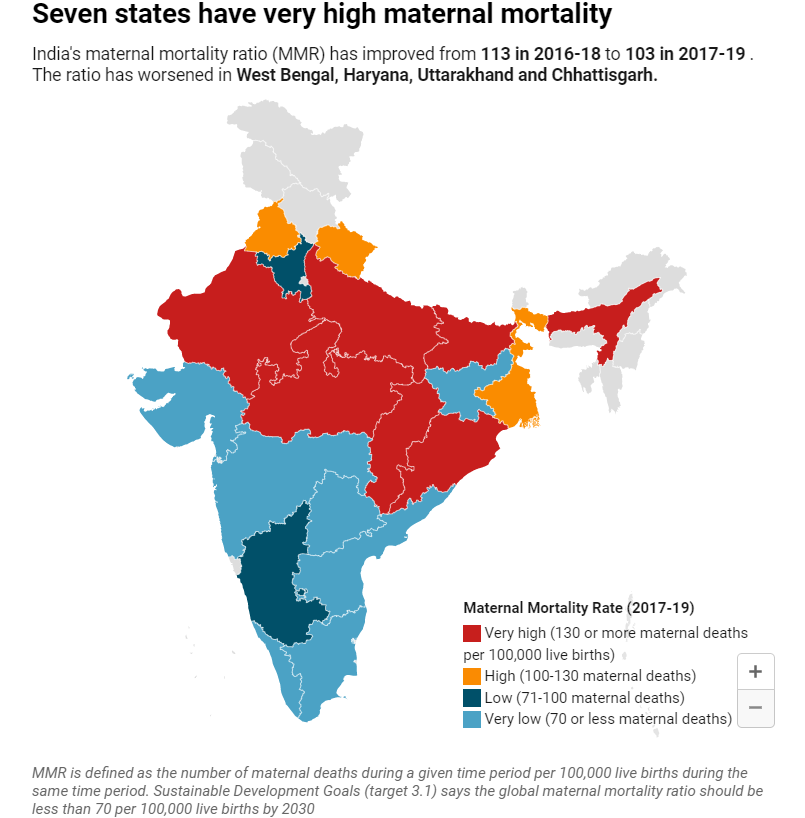Social Justice
Maternal Mortality in India
- 15 Mar 2022
- 5 min read
For Prelims: Maternal Mortality Ratio, Registrar General of India, World Health Organisation.
For Mains: Issues Related to Women, Health, Human Resource, Maternal Mortality Ratio and Related Initiatives.
Why in News?
Recently, the Registrar General of India’s Sample Registration System (SRS) released the latest special bulletin on Maternal Mortality in India (2017-19).
- As per the World Health Organisation, maternal death is the death of a woman while pregnant or within 42 days of termination of pregnancy, from any cause related to or aggravated by the pregnancy or its management.
- Maternal Mortality Ratio (MMR) is defined as the number of maternal deaths during a given time per 1,00,000 live births during the same time.
What is the Registrar General of India?
- It is under the Ministry of Home Affairs.
- Apart from conducting the Population Census and monitoring the implementation of the Registration of Births and Deaths in the country, it has been giving estimates on fertility and mortality using the Sample Registration System (SRS).
- SRS is the largest demographic sample survey in the country that among other indicators provide direct estimates of maternal mortality through a nationally representative sample.
- Verbal Autopsy (VA) instruments are administered for the deaths reported under the SRS on a regular basis to yield a cause-specific mortality profile in the country.
Where does India Stand on MMR?
- The MMR of India has declined by 10 points. It has declined from 113 in 2016-18 to 103 in 2017-19 (8.8 % decline).
- The country had been witnessing a progressive reduction in the MMR from 130 in 2014-2016, 122 in 2015-17, 113 in 2016-18, and to 103 in 2017-19.
- India was on the verge of achieving the National Health Policy (NHP) target of 100/lakh live births by 2020 and certainly on track to achieve the United Nations Sustainable Development Goals target of 70/ lakh live births by 2030.
- Many developed countries have successfully brought down MMR to single digits. Italy, Norway, Poland and Belarus have the lowest MMR of two, while it is seven in both Germany and the UK, 10 in Canada and 19 in the US.
- Most of India’s neighbours — Nepal (186), Bangladesh (173) and Pakistan (140) — have a higher MMR. However, China and Sri Lanka are way ahead with MMRs of 18.3 and 36 respectively.
What are the State Specific Findings?
- The number of States that have achieved the SDG target has now risen from five to seven -- Kerala (30), Maharashtra (38), Telangana (56), Tamil Nadu (58), Andhra Pradesh (58), Jharkhand (61), and Gujarat (70).
- Kerala has recorded the lowest MMR which puts Kerala way ahead of the national MMR of 103.
- Kerala’s Maternal MMR has dropped by 12 points. The last SRS bulletin (2015-17) had put the State’s MMR at 42 (later adjusting it to 43).
- There are now nine States that have achieved the MMR target set by the NHP, which include the above seven and Karnataka (83) and Haryana (96).
- Uttarakhand (101), West Bengal (109), Punjab (114), Bihar (130), Odisha (136) and Rajasthan (141) -- have the MMR in between 100-150, while Chhattisgarh (160), Madhya Pradesh (163), Uttar Pradesh (167) and Assam (205) have the MMR above 150.
What are some Related Government Initiatives?
- Janani Suraksha Yojana under the National Health Mission to link cash assistance to institutional deliveries.
- The Pradhan Mantri Surakshit Matritva Abhiyan (PMSMA) provides a fixed day for assured, comprehensive and quality antenatal care free of cost to pregnant women on 9th of every month.
- Pradhan Mantri Matru Vandana Yojana, Poshan Abhiyan and LaQshya Guidelines.
Way Forward
- Maternal mortality in a region is a measure of reproductive health of women in the area.
- The WHO has already appreciated India’s efforts in reducing the maternal mortality rate. India needs to give a special focus to states with higher MMR.








